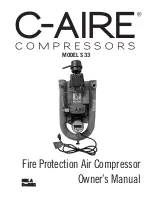
TROUBLESHOOTING GUIDE
MAINTENANCE /
REP
AIR
TROUBLESHOOTING
OPERA
TION
ASSEMBL
Y /
INST
ALLA
TION
SAFETY /
SPECIFICA
TIONS
GETTING ST
AR
TED
12
OPERA
TION
SYMPTOM
POSSIBLE CAUSE(S)
CORRECTIVE ACTION
Low discharge pressure
1. Air demand exceeds pump capacity
1. Reduce air demand or use a compressor with more
capacity.
2. Restricted air intake
2. Clean or replace the air filter element.
3. Air leaks (fittings, tubing on
compressor, or plumbing outside of
system)
3. Listen for escaping air. Apply soap solution to
all fittings and connections. Bubbles will appear
at points of leakage. Tighten or replace leaking
fittings or connections. Use pipe thread sealant.
4. Blown gaskets
4. Replace any gaskets proven faulty on inspection.
5. Leaking or damaged valves
5. Remove head and inspect for valve breakage,
misaligned valves, damaged valve seats, etc.
Replace defective parts and reassemble.
Unit care and maintenance.
Install a new head gasket each
time the head is removed.
Excessive noise (knocking)
1. Loose motor pulley or flywheel
1. Tighten pulley / flywheel clamp bolts and set-screws.
2. Loose fasteners on pump or motor
2. Tighten fasteners.
3. Lack of oil in crankcase
3. Check for proper oil level; if low, check for possible
damage to bearings. Dirty oil can cause excessive
wear.
4. Worn connecting rod
4. Replace connecting rod. Maintain oil level and
change oil more frequently.
5. Worn piston pin bores
5. Remove piston assemblies from the compressor and
inspect for excess wear. Replace excessively worn
piston pin or pistons, as required. Maintain oil level
and change oil more frequently.
6. Piston hitting the valve plate
6. Remove the compressor head and valve plate
and inspect for carbon deposits or other foreign
matter on top of piston. Replace head and valve
plate using new gasket. See Lubrication section for
recommended oil.
7. Noisy check valve in compressor
system
7. Replace check valve.
Risk of Explosion. Do not
disassemble check valve with air
pressure in tank.
Large quantity of oil in the
discharge air
NOTE:
In an oil-lubed
compressor there will always
be a small amount of oil in the
air stream.
1. Worn piston rings
1. Replace with new rings. Maintain oil level and
change oil more frequently.
2. Compressor air intake restricted
2. Clean or replace filter. Check for other restrictions
in the intake system.
3. Excessive oil in compressor
3. Drain down to full level.
4. Wrong oil viscosity
4. Use Mobil 1
®
10W-30 or full synthetic.
Water in discharge air / tank
Normal operation. The amount of water
increases with humid weather
1. Drain tank more often. At least daily.
2. Add a filter to reduce the amount of water in the
air line.
Motor hums and runs slowly
or not at all
1. Low voltage
1. Check incoming voltage. It should be approximately
230 volts. Motor will not run properly on 208 volts.
Low voltage could be due to wires (from electrical
source to compressor) being too small in diameter
and / or too long. Have a qualified electrician check
these conditions and make repairs as needed.
2. Use of extension cord
2. Do not use an extension cord. Use longer air hose
with larger diameter.
3. Too many devices on same circuit
3. Limit the circuit to the use of compressor only
4. Loose electrical connections
4. Check all electrical connections.
5. Malfunctioning pressure switch -
contacts will not close
5. Replace pressure switch.
6. Malfunctioning check valve
6. Replace check valve.
Risk of Explosion. Do not
disassemble check valve with
air pressure in tank.
Содержание VT6358
Страница 67: ...NOTES NOTAS ...
Страница 68: ...NOTES NOTAS ...















































